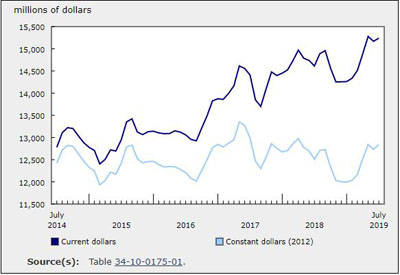Canadian Survey on Business Conditions — Q2 2021

May 31, 2021
Real gross domestic product grew 0.4% in February, after having grown 0.7% in January. This 10th consecutive monthly increase continued to offset the steepest drops in Canadian economic activity on record in March and April 2020. However, total economic activity was about 2% below the level observed in February 2020, before the COVID-19 pandemic.
Throughout April 2021, Statistics Canada conducted the Canadian Survey on Business Conditions. The survey collects information on business expectations moving forward and the ongoing impact of the pandemic on businesses in Canada.
Over the next three months, one-third of businesses expected their profitability to decrease, one-quarter expected their sales to decrease, one-fifth expected to increase the prices they charge and three-quarters expected their number of employees to remain the same. Businesses were concerned with future survival and expected to face a variety of obstacles in the short term.
Many businesses anticipate lower profitability in the short term
Over one-third (37.1%) of all businesses and over half (51.6%) of businesses in accommodation and food services expected their profitability to decrease over the next three months (see note to readers). Conversely, 12.4% of businesses expected their profitability to increase, most notably, those in wholesale trade (19.4%), manufacturing (18.0%) and retail trade (17.0%).
Just over one-quarter (25.7%) of businesses expected their sales to decrease over the next three months, down from nearly one-third of businesses last quarter. Businesses in accommodation and food services (42.1%) were most likely to expect sales to fall.
Nearly one-fifth (19.9%) of businesses expected to raise prices over the next three months, up from 14.0% last cycle, with those in manufacturing (33.9%), wholesale trade (33.7%) and construction (31.0%) most likely to expect to do so.
Over three-quarters (77.6%) of businesses expected their number of employees to remain the same over the next three months, up from 70.6% last cycle. Conversely, 8.8% of businesses expected their number of employees to decrease, down from 11.7% last quarter. Over one-fifth (20.5%) of businesses in accommodation and food services expected a reduction in their number of employees over the next three months, down from 29.6% last quarter.
In terms of vacant positions, 6.8% of businesses expected to have more job vacancies over the next three months. In accommodation and food services, 13.4% of businesses expected to have more vacant positions.
Business survival and plans over the next year
Over two-thirds (68.5%) of businesses reported they could continue to operate at their current level of revenue and expenditures for 12 months or more before considering closure or bankruptcy. Similar to last quarter, almost 1 in 10 (9.5%) businesses reported they could continue for less than 12 months. Under one-quarter of businesses in accommodation and food services (22.8%) reported they could continue to operate at their current level of revenue and expenditures for less than 12 months before having to consider closure or bankruptcy, down from 24.9% of businesses last quarter.
Over three-fifths (61.6%) of businesses reported they could continue to operate at their current level of revenue and expenditures for 12 months or more before considering laying off staff, while just over one-fifth (20.7%) reported they could continue for less than 12 months before considering laying off staff. Businesses in accommodation and food services (38.4%) and arts, entertainment and recreation (29.4%) were most likely to report they could continue to operate at their current level of revenue and expenditures for less than 12 months before considering laying off staff.
One in eight businesses (12.1%) had plans to expand or restructure, or had plans to acquire or invest in other businesses in the next year. Similar to last cycle, 2.9% of businesses had plans to transfer or sell their business within the next year. Meanwhile, 1.3% of businesses had plans to close their business, down from 2.4% of businesses last quarter.
Three-quarters (75.0%) of businesses had the cash or liquid assets required to operate over the next three months. While two-fifths (42.9%) of businesses reported that they did not need to take on more debt, 14.8% of businesses reported that they could not take on more debt. Of businesses that could not take on more debt, the most commonly reported reasons were lack of confidence or uncertainty in future sales (56.2%), cash flow (47.2%) and expectations that the request would be turned down (22.0%). Just over one-quarter (25.3%) of businesses in accommodation and food services and over one-fifth (23.6%) of businesses in mining, quarrying, and oil and gas extraction reported that they did not have the ability to take on more debt.
Businesses expect to face a variety of obstacles
During these uncertain times, businesses are faced with a variety of obstacles and future unknowns. The rising cost of inputs, including labour, capital, energy and raw materials, was the most commonly expected obstacle over the next three months (37.8%), up from 25.5% of businesses that expected this to be an obstacle last quarter. The rising cost of inputs was expected to be an obstacle for around three-fifths of businesses in construction (62.1%), agriculture, forestry, fishing and hunting (62.0%), and manufacturing (59.2%).
Businesses expected to face obstacles related to the workforce. Recruiting skilled employees was expected to be an obstacle for over one-quarter (27.8%) of all businesses, led by businesses in manufacturing (39.1%), construction (35.2%), retail trade (32.4%), and accommodation and food services (32.3%). In addition, shortage of labour force (23.8%) and retaining skilled employees (22.1%) were expected obstacles for over one-fifth of businesses.
Over one-quarter (27.8%) of businesses expected attracting new or returning customers to be an obstacle over the next three months. It was expected to be an obstacle for over two-fifths of businesses in information and cultural industries (43.2%), accommodation and food services (42.6%), and arts, entertainment and recreation (41.4%).
Businesses shift to increase online sales capabilities
The onset of the COVID-19 pandemic, combined with temporary store closures and physical distancing measures, prompted many Canadian retailers to open or expand their e-commerce presence, quickly changing the retail landscape. Retail e-commerce rose from 3.5% of total retail sales in 2019 to 5.9% in 2020. In December alone, online sales were up by over two-thirds (+69.3%) year over year to $4.7 billion.
In addition to efforts made by businesses to increase e-commerce capabilities over the past year, businesses planned to continue to make such investments. Just over one-fifth (20.1%) of all businesses were likely to invest in online sales or e-commerce capabilities over the next 12 months. Businesses in information and cultural industries (41.8%), retail trade (37.8%), and wholesale trade (36.1%) were most likely to invest in online sales or e-commerce capabilities over the next 12 months.
Almost one-fifth (18.6%) of businesses reported they were likely going to permanently increase their online sales capacity once the COVID-19 pandemic is over. Businesses in retail trade (37.0%) and wholesale trade (34.3%) were most likely to report permanently increasing their online sales capacity once the COVID-19 pandemic is over.
The availability of 5G wireless technology is expected to have a moderate or major impact on 16.2% of businesses, led by businesses in information and cultural industries (27.5%).
Source: Statistics Canada, www150.statcan.gc.ca/n1/daily-quotidien/210528/dq210528b-eng.htm?CMP=mstatcan
Photo: Tech Daily on Unsplash











